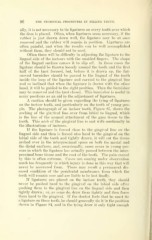Page 204 - My FlipBook
P. 204
86 THE TECHNICAIi PEOCEDUBES IN FILLING TEETH.
ally, it is not necessary to tie ligatures on every tooth over which
the dam is placed. Often, when ligatures seem necessary, if the
rubber is just drawn down well, the ligature may be at once
removed and the rubber will remain in position. Ligatures are
often painful, and when the results can be well accomplished
without them, they should not be used.
Often there will be difficulty in adjusting the ligature to the
lingual side of the incisors with the unaided fingers. The shape
of the lingual surface causes it to slip off. In these cases the
ligature should be thrown looseh^ around the tooth and tlie first
half of the Imot formed, but, before it is drawn up, the flat-
curved burnisher should be passed to the lingual of the tooth
inside the loop of the ligature and carried to the gingival line
and so inclined that when the ligature is drawn with the other
hand, it will be guided to the right yjosition. Then the burnisher
may be removed and the knot closed. This burnisher is useful in
many positions as an aid in the adjustment of ligatures.
A caution should be given regarding the tying of ligatures
on the incisor teeth, and particularly on the teeth of young peo-
ple. The photograph of an incisor tooth, Figure 85, shows the
arching of the giu";ival line over from labial to lingual, which
is the line of the normal attachment of the giun tissue to the
tooth. This arch of the gingival line is met with continually in
the illustrations of incisors.
If the ligature is forced close to the gingival line on the
lingual side and then is forced also hard to the gingival on the
labial side of the tooth and tightly drawn, it will cut the tissue
arched over in the interproximal space on both the mesial and
the distal surfaces, and, occasionally, cases occur in young per-
sons in which the ligature has actually passed between the inter-
proximal bone tissue and the root of the tooth. The pain caused
by this is often extreme. Cases are coming under observation
much too frequently in which injury is done in this way that will
never be recovered from. '^Pliere may result a permanent dis-
eased condition of the peridental membranes from which the
teeth will remain sore and are liable to be lost tinally.
If ligatures are placed on the incisor teeth, they should
never be pushed hard to the gingival on the labial side after
pushing them to the gingival line on the lingual side and then
tightly drawn ; or, as some do, draw them tiglitly and then force
them hard to the gingival. If the dentist feels that he must tie
a ligature on these teeth, he should generally tie it in the position
shown in Figure S4, ;nid in Ihc tying draw it only tight enough


